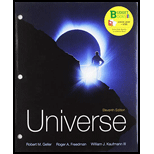
The interpretation that can be drawn when the speed of a Moon or Satellite is given (Kepler’s third law), and the time used by the satellite to disappear during its orbit behind its planet is measured.
Answer to Problem 1CC
Solution:
The diameter of a satellite can be estimated when it is screened by a planet and the visibility of satellite reflected light is less. So, the time used by the satellite to fade away reveals its transit time and speed, through which the diameter of the satellite can be estimated.
Explanation of Solution
Introduction:
Satellite is an artificial device that is used to visualize distant objects like stars, galaxies, and other astronomical objects from the Earth’s atmosphere. It provides a signal from one side of the Earth to the other side of the Earth, and acts like a giant mirror in space. It gives clear and sharp images of the Earth, planets, and other astronomical objects.
Explanation:
When the satellite passes between humans and planets, they emerge from the planet’s shadow. There is a brief time interval in which the satellite increases, as more of its surface exposed under sunlight. During this period, the diameter of the satellite and its transit time can be calculated by this interval of its appearance and disappearance.
Conclusion:
Therefore, it is concluded that the transit time and diameter of a satellite are calculated by its appearance and disappearance.
Want to see more full solutions like this?
Chapter 13 Solutions
Universe - Text Only (Looseleaf)
- One planet is three times farther from the Sun than another. Will the farther planet take more, less, or the same amount of time to orbit the Sun? Will the closer planet orbit slower, faster, or the same speed? How much longer will the farther planet take to orbit than the closer planet? If the closer planet is located at 10 AU, how far is the farther planet, and what are the two planet's names?arrow_forwardhow can you show relative distances of the planets from the sunarrow_forwardWhy is it important to study satellites and planetary motion?arrow_forward
- Which would have the longer orbital period: a moon 1 million km from the center of Jupiter, or a moon 1 million km from the center of Earth? Why?arrow_forwardThe Moon requires about 1 month (0.08 year) to orbit Earth. Its distance from us is about 400,000 km (0.0027 AU). Use Kepler’s third law, as modified by Newton, to calculate the mass of Earth relative to the Sun.arrow_forwardConsider a person in the United States who sees the last-quarter phase of the Moon. (a) Which side of the Moon is illuminated? (b) What phase does an observer in Australia see at the same time, and which side is bright?arrow_forward
- The day on Mars is 1.026 Earth-days long. The martian year lasts 686.98 Earth-days. The two moons of Mars take 0.32 Earth-day (for Phobos) and 1.26 Earth-days (for Deimos) to circle the planet. You are given the task of coming up with a martian calendar for a new Mars colony. Would a solar or lunar calendar be better for tracking the seasons?arrow_forwardWhich is the phase of Venus when it is closest? Which when farthest? How do you know?arrow_forwardConsider a person in the United States who sees the first-quarter phase of the Moon. (a) Which side of the Moon is illuminated, east or west? (b) What phase does an observer in Australia see at the same time, and which side is bright?arrow_forward
 An Introduction to Physical SciencePhysicsISBN:9781305079137Author:James Shipman, Jerry D. Wilson, Charles A. Higgins, Omar TorresPublisher:Cengage Learning
An Introduction to Physical SciencePhysicsISBN:9781305079137Author:James Shipman, Jerry D. Wilson, Charles A. Higgins, Omar TorresPublisher:Cengage Learning AstronomyPhysicsISBN:9781938168284Author:Andrew Fraknoi; David Morrison; Sidney C. WolffPublisher:OpenStax
AstronomyPhysicsISBN:9781938168284Author:Andrew Fraknoi; David Morrison; Sidney C. WolffPublisher:OpenStax
 Foundations of Astronomy (MindTap Course List)PhysicsISBN:9781337399920Author:Michael A. Seeds, Dana BackmanPublisher:Cengage Learning
Foundations of Astronomy (MindTap Course List)PhysicsISBN:9781337399920Author:Michael A. Seeds, Dana BackmanPublisher:Cengage Learning Stars and Galaxies (MindTap Course List)PhysicsISBN:9781337399944Author:Michael A. SeedsPublisher:Cengage Learning
Stars and Galaxies (MindTap Course List)PhysicsISBN:9781337399944Author:Michael A. SeedsPublisher:Cengage Learning





